MODERNIST JEWELRY & SILVER
Identifying Popular Mid-20thC Designs of Value
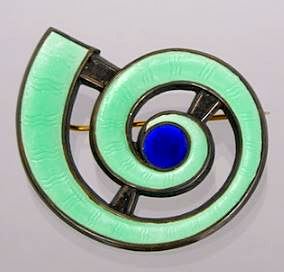
Welcome to a brief overview of Modernism, an artistic and cultural movement that emerged in response to traditional forms of expression. In Western societies, it is widely believed to have originated during the late 19th century Industrial Revolution. Modernism is characterized by a departure from Romanticism, Realism, and Classicism, which had been the dominant veins of artistic thought since the 17th century.
One of the most notable features of Modernism was its rejection of traditional techniques and materials. Artists experimented with new materials, such as steel and concrete, and created works that defied traditional forms and structures. The movement also embraced a new kind of subject matter, exploring the inner workings of the mind and the subconscious, and challenging the viewer's perception of reality.
Modernism had a profound impact on the arts, culture, and society as a whole. It paved the way for new artistic movements such as Surrealism, Abstract Expressionism, and Pop Art. The principles of Modernism also influenced fields such as architecture, design, and literature, and continue to shape the way we think about and create art today.
The Evolution of Modernist Designs
Initially, Modernism incorporated similar themes and subjects to its predecessors, but it transformed them into more imaginative and free-flowing forms, often without strict adherence to precision or scale. The movement emphasized the importance of experimentation, self-expression, and individualism, and sought to challenge the conventional ideas of beauty and aesthetics.
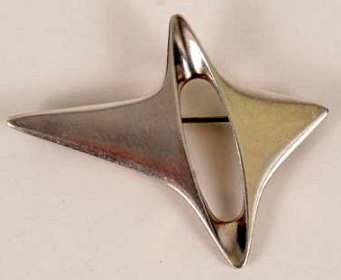
During the early stages of Modernism, many artists were fascinated with new technological advancements and their impact on society, often incorporating these themes into their work. The movement was also influenced by the changing social and political climate of the time, which brought about a new sense of individualism and a desire for freedom of expression.
Although the first Modernist designs were primarily observed in numerous examples of early 20th-century fine arts, furniture, and architecture, they quickly spread to the so-called Decorative Arts, including ceramics, jewelry, and silver making. This sudden change saw designs becoming practically void of any ornate detailing and at times purely functional, with an utterly minimalist aesthetic.
In essence, Modernist designs enveloped and subsumed the overall item, expressing it as a total form with clean or all-encompassing edge lines that served a specific functional purpose and lacked any unnecessary artistic excesses. The focus was on simplicity, functionality, and a streamlined aesthetic. This new approach to design was a significant departure from traditional decorative arts, which placed great emphasis on intricate details and ornamentation. The minimalist aesthetic of Modernism reflected the changing social and cultural climate of the time, which prioritized functionality and simplicity over ostentation.
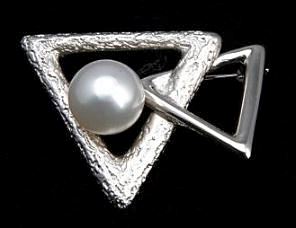
Most collectors know of the prolific Modernist creations of several jewelers & silversmiths or designers from the various Scandinavian countries. Notable examples include jewelry & silverware by JENSEN (Denmark), ANDERSEN (Norway), DITZEL (Denmark), JORGENSEN (Norway), WECKSTROM (Finland), LILJEDAHL (Sweden), SIERSBOL (Denmark), JUHLS (Norway), CHRISTOFFERSEN (Norway) and many others. In some cases, entire Studios or larger manufacturing jewelers & silversmiths also produced items of exceptional workmanship and imagination, such as NORSK PLUS DESIGNS (Norway), ATELIER BORGILA (Sweden), AURAN KULTASEPPA OY (Finland) and several others, that often employed many accomplished Artisans. Other notable designers that flourished and excelled in this style and located elsewhere, including the USA, include EVERETT MacDONALD (Los Angeles, CA), ED WIENER (NY & RI), BETTY COOKE (Baltimore, MD), ARNE MYHRE [KALO SHOP] (Chicago, IL) and several others.
Our marks4silver section on our marks4antiques.com research website, includes the most complete and comprehensive reference library of makers’ marks and trademarks documented or registered by Modernist jewelers & silversmiths throughout the world.
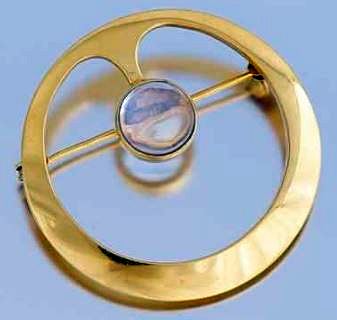
The Modernist movement reached its peak between the 1930s and 1950s when many jewelers and silversmiths recognized the increasing popularity of these patterns among both men and women. This period marked a unique sociological event, with different perspectives on beauty merging for the two genders.
The impact of Modernist design was far-reaching and influential. Its principles continue to influence contemporary design, and its legacy can be seen in fields such as architecture, product design, and graphic design. Because modernist designs represented a departure from traditional forms of decorative art, emphasizing simplicity, functionality, and a streamlined aesthetic, this approach continues to influence contemporary designers, reflecting the changing social and cultural climate of the time, and shaping the way we think about and create functional art today.
Appreciating Modernist Jewelry
In particular, the evolution of Modernist jewelry reflects a tamed approach to ornate detailing associated primarily with feminine designs, merging with the pragmatic style traditionally adorned by men. This crossroads resulted in simpler, almost "manly" Modernist jewelry that had a unisex appeal, appealing to both men and women.
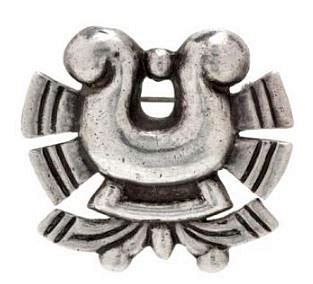
The beauty of Modernist jewelry lies in its ability to express beauty through simplicity. The monotonic and continuous form or shape of the pieces allows the eye to appreciate them as one total construct, creating an almost indescribably mystical or soothing effect.
The popularity of Modernist jewelry and silver continues to this day, with its legacy seen in contemporary jewelry design.
Researching Modernist Designs
For serious collectors and dealers, correctly attributing the maker and age of Modernist jewelry and silverware is crucial to establishing their value. The intrinsic value of the precious metal used in these items is of lesser importance compared to the popularity of the designer. At auction or in exchanges between dealers, famous designers fetch much higher prices than lesser-known craftsmen.
While some great designs made by obscure craftsmen also fare well at auction, they are not as easy to advertise or sell since it takes a more dedicated and knowledgeable collector to appreciate them. On the other hand, mass-produced Modernist designs of any kind are simply worth their weight in precious metal and do not hold much value beyond that. However, they could become more valuable as interesting mementos of an era in later times.
It is crucial to note that correctly attributing the maker and age of Modernist jewelry and silverware is key to establishing their price. A thorough understanding of the history of Modernist design is necessary to distinguish between designs made by famous designers and those made by lesser-known craftsmen. This knowledge allows collectors and dealers to make informed decisions about their purchases and appraisals.
At its core, the value of Modernist jewelry and silverware lies in its historical significance and design innovation. By appreciating the unique beauty and simplicity of these pieces and understanding their historical context, we can gain a deeper appreciation of the artistry and craftsmanship involved.
Avoiding Modernist Misconceptions
Modernist jewelry and silverware have become highly sought-after items for collectors and enthusiasts alike. However, it's crucial to establish the authenticity and attribution of these pieces to determine their true value. This is especially true when it comes to famous designers, whose creations fetch much higher prices than their lesser-known counterparts.
It's worth noting that not all collectibles advertised as Modernist are genuine. Many Mexican-made pieces, while highly desirable in their own right, often symbolize Aztec or Mayan historical themes and shapes and are not related to the convoluted and intertwined forms characteristic of true Modernist designs. Similarly, Native American jewelry, steeped in tradition and tribal references, often bears remarkable similarity to modernist designs but should not be referred to as such.
However, there are exceptions to this rule, with some designers such as Pineda and Sigi deviating from the traditional Mexican style to create magnificent silverware and modernist tableware in a contemporary manner. It takes a more dedicated and knowledgeable collector to appreciate the value of such items, but they can be just as worthy of attention as those made by more famous designers.
Conclusion
In summary, Modernism was a revolutionary movement that challenged traditional forms of expression in the Arts & Culture. It was characterized by experimentation, self-expression, and individualism, and sought to challenge conventional ideas of beauty and aesthetics. Modernism continues to influence contemporary art and culture, and its impact can be seen in many different fields of creative expression. As such, Modernist design represented a departure from traditional forms of decorative art, emphasizing simplicity, functionality, and a streamlined aesthetic. This approach to design continues to influence contemporary design, reflecting the changing social and cultural climate of the time, and shaping the way we think about and create functional art today.
When it comes to Modernist jewelry and silver collectibles it's essential to establish the authenticity and attribution of a piece to determine its true value. While many imposter pieces exist, there are also exceptions where lesser-known designers created exceptional and innovative designs worthy of recognition. By avoiding common misconceptions and understanding the distinct characteristics of authentic Modernist pieces, collectors and enthusiasts can build a valuable and unique collection.
Unlock the true value
of your collection with our comprehensive research guides from identifying makers' marks to appraising all kinds of
antiques and collectibles.
Our up-to-date information will give you an accurate understanding of your items' worth. Don't miss out on this
valuable resource - visit our research tools today!
Search our price guide for your
own treasures





